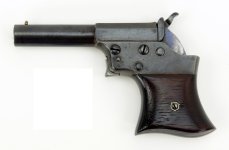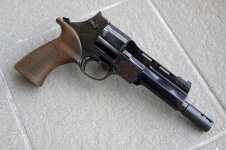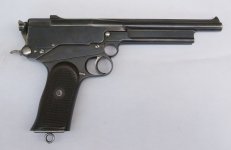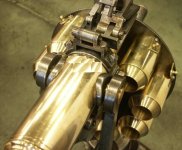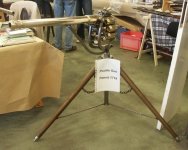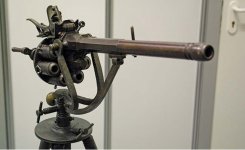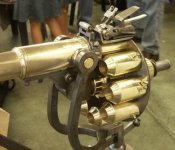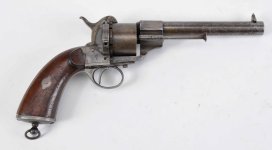You are using an out of date browser. It may not display this or other websites correctly.
You should upgrade or use an alternative browser.
You should upgrade or use an alternative browser.
What the heck
- Thread starter Ozzieman
- Start date
dakota.potts
New member
That looks like a Chiappa Rhino
dakota.potts
New member
On second look, you're right. That appears to be a Mateba Unica auto revolver?
Mike Irwin
Staff
"GarandTd I will give you 50% on that.
4 Remington "Saw Handle" Derringer
They were built between 1865 and 1888 and 15,000 were built. I have seen them listed from 22, 30 and 41 Rimfire"
Give him 100%, he's correct.
The "Saw Handle" name was never used by Remington, only later.
Officially it was called the Number 1 Vest Pocket pistol, or the Elliot Vest Pocket Pistol.
Here's a picture of one in a box that shows the name that Remington used.
http://www.rockislandauction.com/detail/57/1087
Amazingly, that one still has the ejector rod. Those are FAR rarer than the pistols themselves, and I suspect that that, and the box, are why this one is so pricey.
4 Remington "Saw Handle" Derringer
They were built between 1865 and 1888 and 15,000 were built. I have seen them listed from 22, 30 and 41 Rimfire"
Give him 100%, he's correct.
The "Saw Handle" name was never used by Remington, only later.
Officially it was called the Number 1 Vest Pocket pistol, or the Elliot Vest Pocket Pistol.
Here's a picture of one in a box that shows the name that Remington used.
http://www.rockislandauction.com/detail/57/1087
Amazingly, that one still has the ejector rod. Those are FAR rarer than the pistols themselves, and I suspect that that, and the box, are why this one is so pricey.
dakota.potts You got it
5 Mateba Autorevolver
https://en.wikipedia.org/wiki/Mateba_Autorevolver
The Mateba Model 6 Unica (often known simply as the Mateba or the Mateba Autorevolver) is a recoil operated semi-automatic revolver, one of only a few of this type ever produced. It was developed by Mateba, based in Pavia, Italy.
Emilio Ghisoni (d. 2008) is listed as the owner of US Patent #4,712,466 which details the operation of the weapon.
Design[edit]
The Mateba Model 6 uses the recoil from firing to rotate the cylinder and cock the hammer, unlike conventional revolvers, which depend on the user physically pulling the trigger and/or cocking the hammer to actuate the weapon's mechanism of operation.
The Mateba Autorevolver's barrel alignment is different from most other revolvers. The barrel is aligned with the bottom of the cylinder instead of the top. This lowers the bore axis (line of the barrel) which directs the recoil in line with the shooter's hand thereby reducing the twisting motion or muzzle flip of normal revolvers.[1]
The gun's entire upper assembly (barrel, cylinder and frame) are mounted on rails on the lower frame, which houses the trigger, hammer, and grip, and recoils 1/2 of an inch, or 12.7mm, on firing. The rearward motion of the upper assembly cocks the hammer, and the cylinder is rotated on the forward stroke.[2]
Variants[edit]
The following are variants of the Mateba revolver:[3][4][5][6]
Defense - 4" Barrel, .357 Magnum
Home Protection - 5" Barrel, .44 Remington Magnum
Dynamic Sportiva - Either 5" or 6" barrel, .357 Magnum
Hunter - 8 3/8" Barrel, .357 Magnum (.38 Special) and .44 Remington Magnum (.44 S&W Special)
In addition, their barrels can be changed with interchangeable 3", 4", 5", 6", 7" and 8" inch barrels.
Mateba Autorevolvers chambered in .357 Magnum can be loaded with .38 Special ammunition. Typical .38 Special loads do not have enough power to fully cycle the recoil mechanism, but the weapon will still function with a double-action trigger pull.[1] There are two optional recoil springs designed specifically for .38 Special cartridges that can be installed by the operator to overcome this problem (.38 Special and .38 wadcutter). Replacing the spring requires the removal of the slide assembly, which is blocked by a retaining pin held in place by a small set screw in the triggerguard. The barrel shroud acts as the spring keeper and guide rod bushing.
5 Mateba Autorevolver
https://en.wikipedia.org/wiki/Mateba_Autorevolver
The Mateba Model 6 Unica (often known simply as the Mateba or the Mateba Autorevolver) is a recoil operated semi-automatic revolver, one of only a few of this type ever produced. It was developed by Mateba, based in Pavia, Italy.
Emilio Ghisoni (d. 2008) is listed as the owner of US Patent #4,712,466 which details the operation of the weapon.
Design[edit]
The Mateba Model 6 uses the recoil from firing to rotate the cylinder and cock the hammer, unlike conventional revolvers, which depend on the user physically pulling the trigger and/or cocking the hammer to actuate the weapon's mechanism of operation.
The Mateba Autorevolver's barrel alignment is different from most other revolvers. The barrel is aligned with the bottom of the cylinder instead of the top. This lowers the bore axis (line of the barrel) which directs the recoil in line with the shooter's hand thereby reducing the twisting motion or muzzle flip of normal revolvers.[1]
The gun's entire upper assembly (barrel, cylinder and frame) are mounted on rails on the lower frame, which houses the trigger, hammer, and grip, and recoils 1/2 of an inch, or 12.7mm, on firing. The rearward motion of the upper assembly cocks the hammer, and the cylinder is rotated on the forward stroke.[2]
Variants[edit]
The following are variants of the Mateba revolver:[3][4][5][6]
Defense - 4" Barrel, .357 Magnum
Home Protection - 5" Barrel, .44 Remington Magnum
Dynamic Sportiva - Either 5" or 6" barrel, .357 Magnum
Hunter - 8 3/8" Barrel, .357 Magnum (.38 Special) and .44 Remington Magnum (.44 S&W Special)
In addition, their barrels can be changed with interchangeable 3", 4", 5", 6", 7" and 8" inch barrels.
Mateba Autorevolvers chambered in .357 Magnum can be loaded with .38 Special ammunition. Typical .38 Special loads do not have enough power to fully cycle the recoil mechanism, but the weapon will still function with a double-action trigger pull.[1] There are two optional recoil springs designed specifically for .38 Special cartridges that can be installed by the operator to overcome this problem (.38 Special and .38 wadcutter). Replacing the spring requires the removal of the slide assembly, which is blocked by a retaining pin held in place by a small set screw in the triggerguard. The barrel shroud acts as the spring keeper and guide rod bushing.
Thanks for the credit, but its the thrill of the hunt and the cool stuff I discover on the journey that is the real reward.
+1 thanks
dakota.potts
New member
Is that a Mars Automatic pistol?
Mike Irwin
Staff
"Is that a Mars Automatic pistol?"
Why yes it is!
Why yes it is!
Yes it is a Mars
8 Mars Automatic Pistol
https://www.bing.com/videos/search?...DB63341902216612858BDB63341902216&FORM=VRDGAR
https://en.wikipedia.org/wiki/Mars_Automatic_Pistol
The Mars Automatic Pistol, also sometimes known as the Webley-Mars, was a semi-automatic pistol developed in 1900 by the Englishman Hugh Gabbet-Fairfax and distributed by the Mars Automatic Pistol Syndicate Ltd. of Birmingham. It was manufactured first by Webley & Scott and later by small gunmakers in Birmingham and London. Manufacture ceased in 1907.
The Mars Automatic Pistol is noted for being available in a variety of 8.5 mm, 9 mm and .45 calibres. These were all bottlenecked cartridges with a large charge of powder, making the .45 version the most powerful handgun in the world for a time. It used a unique long recoil rotating bolt action which ejected spent cartridges straight to the rear, and the feed mechanism is unusual in that it pulls cartridges backwards out of the magazine and then lifts them up into the breech face.
The Mars Automatic Pistol was rejected by the British War Office as a possible replacement for the Webley & Scott revolver, then in service with the British Army, because of the unacceptably large recoil, considerable muzzle flash, and mechanical complexity. The captain in charge of tests of the Mars at the Naval Gunnery School in 1902 observed, "No one who fired once with the pistol wished to shoot it again". Shooting the Mars pistol was described as "singularly unpleasant and alarming".[2] It has since become a collectors' item because of its rarity and as an example of the earliest developments in semi-automatic pistols.
8 Mars Automatic Pistol
https://www.bing.com/videos/search?...DB63341902216612858BDB63341902216&FORM=VRDGAR
https://en.wikipedia.org/wiki/Mars_Automatic_Pistol
The Mars Automatic Pistol, also sometimes known as the Webley-Mars, was a semi-automatic pistol developed in 1900 by the Englishman Hugh Gabbet-Fairfax and distributed by the Mars Automatic Pistol Syndicate Ltd. of Birmingham. It was manufactured first by Webley & Scott and later by small gunmakers in Birmingham and London. Manufacture ceased in 1907.
The Mars Automatic Pistol is noted for being available in a variety of 8.5 mm, 9 mm and .45 calibres. These were all bottlenecked cartridges with a large charge of powder, making the .45 version the most powerful handgun in the world for a time. It used a unique long recoil rotating bolt action which ejected spent cartridges straight to the rear, and the feed mechanism is unusual in that it pulls cartridges backwards out of the magazine and then lifts them up into the breech face.
The Mars Automatic Pistol was rejected by the British War Office as a possible replacement for the Webley & Scott revolver, then in service with the British Army, because of the unacceptably large recoil, considerable muzzle flash, and mechanical complexity. The captain in charge of tests of the Mars at the Naval Gunnery School in 1902 observed, "No one who fired once with the pistol wished to shoot it again". Shooting the Mars pistol was described as "singularly unpleasant and alarming".[2] It has since become a collectors' item because of its rarity and as an example of the earliest developments in semi-automatic pistols.
Good one Scorch
That one only lasted two hours?????
No more mister nice guy.
6 Puckle gun
https://en.wikipedia.org/wiki/Puckle_gun
The Puckle gun (also known as the Defence gun) was a primitive crew-served, manually-operated flintlock[1] revolver patented in 1718 by James Puckle (1667–1724) a British inventor, lawyer and writer. It was one of the earliest weapons to be referred to as a "machine gun", being called such in a 1722 shipping manifest,[2] though its operation does not match the modern use of the term.
Design and patent[edit]
The Puckle gun is a tripod-mounted, single-barreled flintlock weapon fitted with a manually operated[3] revolving cylinder; Puckle advertised its main application as an anti-boarding gun for use on ships. The barrel was 3 feet (0.91 m) long with a bore of 1.25 inches (32 mm). The cylinder held 6 to11 shots depending on configuration, and was hand-loaded with powder and shot while detached from the weapon.[4]
According to the Patent Office of the United Kingdom, "In the reign of Queen Anne, the law officers of the Crown established as a condition of grant that "the patentee must by an instrument in writing describe and ascertain the nature of the invention and the manner in which it is to be performed.""[5] This gun's patent, number 418 of 1718, was one of the first to provide such a description. T.W. Lee remarked, however, that "James Puckle's patent in 1718 contains more rhetorical fervor than technical rigor."[6]
Two versions[edit]
Puckle demonstrated two configurations of the basic design: one, intended for use against Christian enemies, fired conventional round bullets, while the second, designed to be used against the Muslim Turks, fired square bullets. The square bullets were considered to be more damaging. They would, according to the patent, "convince the Turks of the benefits of Christian civilization". The weapon was also reported as able to fire shot, with each discharge containing sixteen musket balls.[7]
Operation[edit]
The Puckle gun was fired in a similar fashion to a conventional flintlock musket; however, after each shot, a crank on the threaded shaft at the rear would be unscrewed to release the cylinder to turn freely. The cylinder would then be advanced by hand to the next chamber, and the crank turned back again to lock the cylinder into the breech of the fixed barrel. The flintlock mechanism could then be primed for another shot: it was triggered using a lever which was separate from the crank assembly.
To reload the weapon, the crank handle could be unscrewed completely to remove the cylinder, which could then be replaced with a fresh one. In this way it was similar to earlier breech-loading swivel guns with a detachable chamber which could be loaded prior to use. The cylinder appears to have been referred to as a "charger" in contemporary documentation.[2]
Production and use[edit]
A prototype was shown in 1717 to the English Board of Ordnance, who were not impressed. At a later public trial held in 1722, a Puckle gun was able to fire 63 shots in seven minutes (approx 9 rounds per minute) in the midst of a driving rain storm.[1][7] A rate of 9 rounds per minute compared favourably to musketeers of the period, who could be expected to fire between 2 and 5 rounds per minute depending on the quality of the troops, with experienced troops expected to reliably manage 3 rounds a minute under fair conditions; it was however inferior in fire rate to earlier repeating weapons such as the Kalthoff repeater which fired up to six times faster.
The Puckle gun drew few investors and never achieved mass production or sales to the British armed forces. As with other designs of the time it was hampered by "clumsy and undependable flintlock ignition" and other mechanical problems.[1] A leaflet of the period sarcastically observed of the venture that "they're only wounded who hold shares therein". Production was highly limited and may have been as few as just two guns, one a crude prototype made of iron, the other a finished weapon made from brass.[ii][7]
John Montagu, 2nd Duke of Montagu, Master-General of the Ordnance (1740-1749), purchased two guns for an ill-fated expedition in 1722 to capture St Lucia and St Vincent. While shipping manifests state "2 Machine Guns of Puckles" (sic) were among the cargo that departed from Portsmouth,[2] there is no evidence that the guns were ever used in battle.[4]
Surviving examples[edit]
Two original examples are on display at former Montagu homes: one at Boughton House and another at Beaulieu Palace.[2] There is a replica of a Puckle gun at Bucklers Hard Maritime Museum in Hampshire. Blackmore's British Military Firearms 1650–1850 lists "Puckle’s brass gun in the Tower of London" as illustration 77, though this appears to have been a gun belonging to the former Montagu estate (at that point owned by the Buccleuch family) on loan to the Tower at the time.[7]
Puckle gun[edit]
Main article: Puckle gun
In 1718, Puckle patented his new invention, the Defence Gun — a tripod-mounted, single-barreled flintlock weapon fitted with a multishot revolving cylinder, designed for shipboard use to prevent boarding. The barrel was 3 feet (0.91 m) long with a bore of 1.25 inches (32 mm) and a pre-loaded cylinder which held 6-11 charges and could fire 63 shots in seven minutes—this at a time when the standard soldier's musket could at best be loaded and fired five times per minute.[1]
Puckle demonstrated two versions of the basic design: one, intended for use against Christian enemies, fired conventional round bullets, while the second variant, designed to be used against the Muslim Turks, fired square bullets which were considered to be more damaging and would, according to its patent, convince the Turks of the "benefits of Christian civilization."[2]
The Puckle Gun drew few investors and never achieved mass production or sales to the British armed forces. One leaflet of the period sarcastically observed, following the business venture's failure, that the gun has "only wounded those who hold shares therein."
According to the Patent Office of the United Kingdom, "In the reign of Queen Anne, the law officers of the Crown established as a condition of patent that the inventor must in writing describe the invention and the manner in which it works." James Puckle's 1718 patent, number 418, was one of the first to provide such a description.
John Montagu, 2nd Duke of Montagu, Master-General of the Ordnance (1740-9), purchased at least two for an ill-fated expedition in 1722 to capture St Lucia and St Vincent. One remains on display at Boughton House and another at Beaulieu Palace (both former Montagu homes).
There is a replica of a Puckle Gun at Bucklers Hard Maritime Museum in Hampshire.
Blackmore's British Military Firearms 1650–1850 lists "Puckle’s brass gun in the Tower of London" as illustration 77:this appears to have been one of the Montagu guns on loan to the Tower at the time.
That one only lasted two hours?????
No more mister nice guy.
6 Puckle gun
https://en.wikipedia.org/wiki/Puckle_gun
The Puckle gun (also known as the Defence gun) was a primitive crew-served, manually-operated flintlock[1] revolver patented in 1718 by James Puckle (1667–1724) a British inventor, lawyer and writer. It was one of the earliest weapons to be referred to as a "machine gun", being called such in a 1722 shipping manifest,[2] though its operation does not match the modern use of the term.
Design and patent[edit]
The Puckle gun is a tripod-mounted, single-barreled flintlock weapon fitted with a manually operated[3] revolving cylinder; Puckle advertised its main application as an anti-boarding gun for use on ships. The barrel was 3 feet (0.91 m) long with a bore of 1.25 inches (32 mm). The cylinder held 6 to11 shots depending on configuration, and was hand-loaded with powder and shot while detached from the weapon.[4]
According to the Patent Office of the United Kingdom, "In the reign of Queen Anne, the law officers of the Crown established as a condition of grant that "the patentee must by an instrument in writing describe and ascertain the nature of the invention and the manner in which it is to be performed.""[5] This gun's patent, number 418 of 1718, was one of the first to provide such a description. T.W. Lee remarked, however, that "James Puckle's patent in 1718 contains more rhetorical fervor than technical rigor."[6]
Two versions[edit]
Puckle demonstrated two configurations of the basic design: one, intended for use against Christian enemies, fired conventional round bullets, while the second, designed to be used against the Muslim Turks, fired square bullets. The square bullets were considered to be more damaging. They would, according to the patent, "convince the Turks of the benefits of Christian civilization". The weapon was also reported as able to fire shot, with each discharge containing sixteen musket balls.[7]
Operation[edit]
The Puckle gun was fired in a similar fashion to a conventional flintlock musket; however, after each shot, a crank on the threaded shaft at the rear would be unscrewed to release the cylinder to turn freely. The cylinder would then be advanced by hand to the next chamber, and the crank turned back again to lock the cylinder into the breech of the fixed barrel. The flintlock mechanism could then be primed for another shot: it was triggered using a lever which was separate from the crank assembly.
To reload the weapon, the crank handle could be unscrewed completely to remove the cylinder, which could then be replaced with a fresh one. In this way it was similar to earlier breech-loading swivel guns with a detachable chamber which could be loaded prior to use. The cylinder appears to have been referred to as a "charger" in contemporary documentation.[2]
Production and use[edit]
A prototype was shown in 1717 to the English Board of Ordnance, who were not impressed. At a later public trial held in 1722, a Puckle gun was able to fire 63 shots in seven minutes (approx 9 rounds per minute) in the midst of a driving rain storm.[1][7] A rate of 9 rounds per minute compared favourably to musketeers of the period, who could be expected to fire between 2 and 5 rounds per minute depending on the quality of the troops, with experienced troops expected to reliably manage 3 rounds a minute under fair conditions; it was however inferior in fire rate to earlier repeating weapons such as the Kalthoff repeater which fired up to six times faster.
The Puckle gun drew few investors and never achieved mass production or sales to the British armed forces. As with other designs of the time it was hampered by "clumsy and undependable flintlock ignition" and other mechanical problems.[1] A leaflet of the period sarcastically observed of the venture that "they're only wounded who hold shares therein". Production was highly limited and may have been as few as just two guns, one a crude prototype made of iron, the other a finished weapon made from brass.[ii][7]
John Montagu, 2nd Duke of Montagu, Master-General of the Ordnance (1740-1749), purchased two guns for an ill-fated expedition in 1722 to capture St Lucia and St Vincent. While shipping manifests state "2 Machine Guns of Puckles" (sic) were among the cargo that departed from Portsmouth,[2] there is no evidence that the guns were ever used in battle.[4]
Surviving examples[edit]
Two original examples are on display at former Montagu homes: one at Boughton House and another at Beaulieu Palace.[2] There is a replica of a Puckle gun at Bucklers Hard Maritime Museum in Hampshire. Blackmore's British Military Firearms 1650–1850 lists "Puckle’s brass gun in the Tower of London" as illustration 77, though this appears to have been a gun belonging to the former Montagu estate (at that point owned by the Buccleuch family) on loan to the Tower at the time.[7]
Puckle gun[edit]
Main article: Puckle gun
In 1718, Puckle patented his new invention, the Defence Gun — a tripod-mounted, single-barreled flintlock weapon fitted with a multishot revolving cylinder, designed for shipboard use to prevent boarding. The barrel was 3 feet (0.91 m) long with a bore of 1.25 inches (32 mm) and a pre-loaded cylinder which held 6-11 charges and could fire 63 shots in seven minutes—this at a time when the standard soldier's musket could at best be loaded and fired five times per minute.[1]
Puckle demonstrated two versions of the basic design: one, intended for use against Christian enemies, fired conventional round bullets, while the second variant, designed to be used against the Muslim Turks, fired square bullets which were considered to be more damaging and would, according to its patent, convince the Turks of the "benefits of Christian civilization."[2]
The Puckle Gun drew few investors and never achieved mass production or sales to the British armed forces. One leaflet of the period sarcastically observed, following the business venture's failure, that the gun has "only wounded those who hold shares therein."
According to the Patent Office of the United Kingdom, "In the reign of Queen Anne, the law officers of the Crown established as a condition of patent that the inventor must in writing describe the invention and the manner in which it works." James Puckle's 1718 patent, number 418, was one of the first to provide such a description.
John Montagu, 2nd Duke of Montagu, Master-General of the Ordnance (1740-9), purchased at least two for an ill-fated expedition in 1722 to capture St Lucia and St Vincent. One remains on display at Boughton House and another at Beaulieu Palace (both former Montagu homes).
There is a replica of a Puckle Gun at Bucklers Hard Maritime Museum in Hampshire.
Blackmore's British Military Firearms 1650–1850 lists "Puckle’s brass gun in the Tower of London" as illustration 77:this appears to have been one of the Montagu guns on loan to the Tower at the time.

